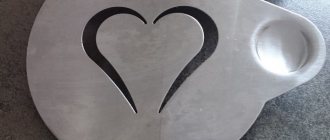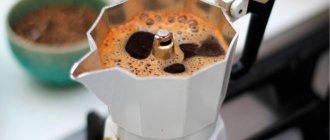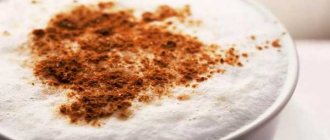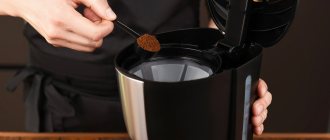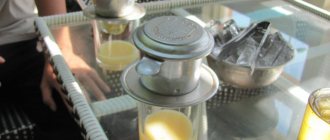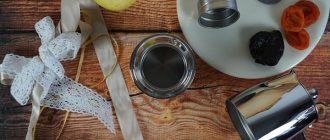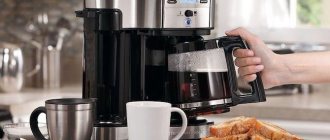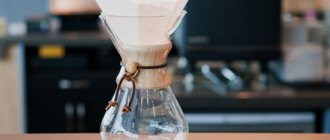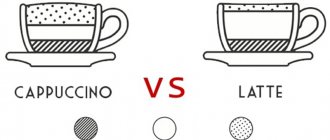Invented in 1908 by German housewife Mellita Benz, this simple method of preparing coffee has become popular throughout the world.
A drip coffee maker, due to its operating principle, does not affect the quality of the drink. With the right ratio of coffee and water, you can brew equally delicious coffee in a coffee shop or in a simple coffee maker at home.
Other names for this drink: Filter coffee, Regular and even sometimes Americano!
Fun fact: filter coffee vs Americano! It all started with American soldiers and their love for black filter coffee.
The drink, which is prepared in an espresso machine, received the name “Americano” during the 2nd World War during the occupation of Italy by US troops.
American soldiers, missing their homeland and missing black coffee, ordered unusually strong “Espresso” from Italian cafes and diluted it with hot water to make the drink look like filter coffee.
Then the Italian baristas nicknamed him “Americano” (which means: American), and wrote down the recipe: “dilute the divine Espresso with boiling water until it is unrecognizable.”
Tea for coffee machine
Manufacturers of famous brands have developed tea recipes for coffee machines. In capsule-type machines, tea is packaged in capsules for the coffee machine. To prepare the drink you need to follow simple steps:
- you need to put the tea capsule into the machine correctly,
- pour water into a special container,
- let it warm up and brew tea with the press of one button.
Delicious drink
Can I brew tea in other coffee makers?
In other coffee makers, tea is brewed using the same principle. For example, in an electric espresso machine, the tea is placed in a filter basket. A geyser coffee maker is also ideal for brewing tea. You just need to replace coffee with tea and enjoy the aromatic and healthy drink.
I have always associated brewing tea with tea bags with sexual intercourse with a condom - everything is good, but something is missing.
Brewing without a bag according to the instructions in a teapot also did not cause optimism. Pour boiling water over it, let it brew for 5 minutes, and then spit tea leaves - a dubious pleasure. The use of various strainers and special glasses with a squeezer complicates an already rather lengthy process. Please note that boiling water for brewing will not appear on its own and you still need to get it somehow.
In a word, continuous problems! Meanwhile, there is a wonderful way in all respects to quickly obtain delicious aromatic tea without any annoying tea leaves in the glass. This is brewing in a regular drip coffee maker - Fig. 1:
Fig.1. Drip coffee makers
Read also: How and why to make a will
I hope there is no need to describe the technical process. I just want to remind you about the operating principle of these coffee makers.
Drip or filter coffee makers get their name from the way the coffee is prepared. They consist of a water tank, a water heater, a conical filter holder and a coffee outlet, that is, the place where the cup is placed. Cold water is poured into the container (hot water can be used to speed up the process), and a filter with ground coffee is placed in the holder. In our case, it will be tea, and it is better to use large-leaf tea. After turning on, the water flows to the heater, and reaching a temperature of 90 - 95 degrees, drop by drop flows onto the filter with coffee powder (tea). After passing through it, it falls into the cup.
Some coffee makers have a useful auto-heating function: under the bowl for ready-made coffee (tea) there is a small metal plate heated by current. This allows you to keep coffee (tea) hot, usually for 20-30 minutes.
A further expansion of the functionality of drip coffee makers is the use of brewing various beneficial herbs that have a beneficial effect on our alcohol-poisoned body.
And, in conclusion, one more pleasant detail. If your coffee-tea maker breaks down, then until you purchase a new one, you can continue to brew tea, using the filter as a tea strainer, and the container can be a cup from a coffee maker or any other suitable size - Fig. 2. True, in this case you will have to take boiling water from outside.
Types of filters
The filter is considered an important element of the coffee maker. It determines how fully the beneficial properties of ground coffee will be transferred to hot water.
Reusable
Many coffee makers are initially equipped with reusable filters. The following products are mainly used:
- Metal. Requires cleaning and washing after each use. The drink may contain small particles of grounds and acquire an unpleasant metallic taste.
- Nylon. Can be used 60-80 times. It is also necessary to wash after each use.
- "Golden". In fact, they are nylon with titanium coating, which extends their service life.
Due to the need to constantly wash reusable filters, many users prefer disposable elements.
Disposable
Disposable filters do not require cleaning; they are simply removed along with the grounds and thrown away. They are able to trap even the smallest particles. Paper filters are mainly used. They do not spoil the taste of coffee and are inexpensive. Bleached and unbleached paper, as well as bamboo fibers, are used for production.
Bleached products are industrially treated with oxygen. Unbleached ones are not processed in any way, so their distinctive feature is a brown tint.
Main advantages of paper filters:
- Eliminate foreign odors.
- Easy to use - easy to install and remove.
- Used for even the finest grind coffee.
- Environmentally friendly, completely decomposes in the environment.
- Unlike reusable ones, they prevent the development of bacteria.
Dimensions
The filter size should match the number of cups of coffee you plan to brew. Therefore, their parameters are designed for 1, 2, 4, 6, etc. Maximum – up to 12 servings. The dimensions are indicated on the packaging. They can be universal and are used in capsule coffee grinders. Their sizes match all brands of devices.
If we consider in more detail, all numbers are divided as follows:
- Numbers 1 and 2 are intended for the smallest coffee makers, which are currently almost never produced.
- Numbers 3 and 4 are the most widespread. Now No. 3 is unified with No. 4 and is not produced separately.
- Filters No. 6 and higher are designed for large coffee makers and coffee machines.
If the required filter is not available, it is recommended to purchase a larger product. They fit well, just need a little trimming on top.
Features of carob coffee makers
The design of the horn devices is not sufficiently different from its brothers. The coffee making process occurs when pressurized steam passes through ground coffee beans.
As a result of heat treatment, oily substances and amino acids begin to be released from the grains, due to which the drink acquires its own taste and smell.
Among the accessories of carob coffee makers there is a reservoir-horn, in fact, that is why the device received such a name. It is into this horn that freshly ground coffee is poured.
To choose a good carob coffee machine, you need to consider several aspects:
- Excellent models of coffee makers are equipped with an iron carob reservoir. This allows you to better warm up the contents, ensuring complete extraction of crushed grains - the transfer of their taste and aromatic parameters into water.
- The pressure in a carob coffee machine should be about 15 bar at the pump and around 9 bar in the carafe. Power characteristics – 1000-1700 W.
- The unit should heat the water to a temperature of 87-95°C, without bringing it to a boil. This is very important, because when crushed grains are processed with boiling water, all the aromatic characteristics of the product quickly disappear, and the drink loses its own corresponding aroma.
As for the dose, you can pour the amount of coffee you need into a cup. The strength of the finished drink depends on how tightly the crushed grains are compressed in the cone. Also important is the degree of grinding of the beans: the finer the coffee fractions, the stronger the drink.
Most models of carob coffee makers are equipped with a tube with a paranello attachment - a cappuccino maker. With the help of such a tool you can whip cream and milk into a dense foam. From time to time, the devices are equipped with coffee grinders and pitchers - containers for milk and cream.
To make delicious coffee using a carob coffee maker, remember the following rules:
- Always pour coffee into a cup/glass that has been heated in advance, then the drink will not cool down while filling the container.
- For carob-type coffee makers, it is better to take medium, finely ground beans.
- Choose the right drink making program.
Important points
To properly brew coffee in a coffee maker, you need to consider several nuances. The quality of the water and coffee product matters
In addition, it is important to correctly calculate the amount of raw materials per serving.
How many spoons of coffee should I put in?
Preparing coffee should begin by determining how much raw material needs to be poured for a given number of servings. As a rule, a couple of teaspoons of ground product are added to one cup of espresso.
What coffee to use
As already mentioned, it is better to use freshly ground coffee for your coffee maker. Preference should be given to Arabica. The use of coffee blends is allowed.
It should be borne in mind that the greater the concentration of robusta, the less quality the drink will be. True, in this case it will be stronger.
What kind of water should I fill?
When brewing coffee in a coffee maker, you should use only bottled or filtered water. Thanks to this, the taste of the drink will significantly improve. In addition, it will be possible to protect the unit from scale.
Even a child can cope with preparing a coffee drink in modern devices. The main thing is to take into account the nuances of using such devices. In this case, you will be able to get excellent results and fully enjoy the taste of your favorite espresso.
A few words about choosing a blend
The flavor and aroma characteristics of the blend depend on the composition:
- 100% Arabica – rich soft taste, tandem of piquant sourness and sweetness;
- Arabica and Robusta blends are an ideal base for coffee and milkshakes due to the combination of sweetness and noble bitterness.
The higher the percentage of robusta, the more pronounced the shades of dark chocolate in the taste and aftertaste. The flavor and aroma bouquet depends on the degree of roasting of the grain.
Light roasting is usually used for elite beans, allowing the subtle and special properties of the beans to be revealed. Medium roast is universal and allows you to get the perfect balance of sweetness and sourness. Dark – for fans of strong drinks with a memorable taste.
Dosage: how much coffee to put in
The standard ratio of coffee weight to water weight for a drip coffee maker is 60 grams of ground beans for every liter of water.
To adjust the richness of the taste, you should change the ratio: more water will give a richer taste, but a less dense body. The same rule applies to coffee, but in reverse order.
By adjusting the grind size, you can achieve the required flavor characteristics: increasing the grinding increases acidity and sweetness, and decreasing the grinding makes the taste more intense.
What is a drip coffee maker
The operating principle of a drip coffee maker also determined its name. The water is heated almost to a boil and in this form passes drop by drop through ground coffee placed in a special filter. From there, the finished drink flows in the same drops into the coffee pot.
This is where the name of the device, known at the beginning of the 19th century, came from. Of course, the devices for this procedure were more primitive, but the hot water was just as saturated with the taste and aroma of the grains. Gradually, with the advent of household appliances, electric coffee makers operating on the drip principle were developed.
Around the middle of the 20th century, the device took shape in its modern form and since then has only developed and improved. Currently, machines provide quick preparation of several servings of coffee at once, without any effort. Most of the processes are automated, so the coffee is prepared without outside intervention. All you have to do is add water and ground coffee by hand.
History of appearance
The chronology of the emergence of a new method of preparing a drink beloved by many is as follows:
- 1710 - the first filter bag appeared in France;
- 1800 - priest Jean-Baptiste de Belloy-Morangle invented a prototype coffee maker;
- 1825 - Briton Benjamin Thompson, Count Rumfoord, demonstrated a percolator; however, the American farmer Hans Goodrich received a patent for it in 1889.
- 1827 - Parisian Moritz demonstrated a coffee maker that was turned over during the brewing process;
- 1908 - the first paper filter was made from a sheet of notebook by German housewife Melitta Benz, who did not like coffee particles in the liquid.
- Mid-20th century — classmates Vincent Marotta and Samuel Glaser, who subsequently offered cooperation to professional engineers, planned to combine Amalia’s invention with a coffee maker.
- 1972 - the first electric drip coffee maker appeared, Mr. Coffee.
Brewing utensils
Brewing tea correctly is not an easy task. In addition to following the cooking technology, you should also take into account the quality of the utensils used for this. Different countries have their own traditions, but in any case, preference is given to dishes that retain heat longer and do not react chemically with water.
The best choice is a porcelain or earthenware teapot. Porcelain is considered a more advantageous option, since it is able to quickly warm up through and through. The Chinese, for example, approach the issue very carefully and choose special “breathing” types of clay.
The shape of the dishes should be cylindrical or spherical. Be sure to have a tight-fitting lid with a small hole to allow air in and steam out. In the Russian tradition, teapots always have a silver strainer, which prevents tea leaves from getting into the drink.
For the tea drinking process, you will also need beautiful porcelain cups, which perfectly maintain the temperature of the tea and have a beneficial effect on the senses. True connoisseurs of the drink should definitely have in their arsenal a silver spoon and a linen napkin, which is used to cover the teapot while the tea steeps.
In the east, elite Chinese tea is brewed in a special flask. This is not only very convenient and protects your fingers from burns, but also allows you to make the infusion crystal clear
The flask consists of two cylindrical vessels that are placed one inside the other. The inner vessel has small holes through which the finished infusion is poured into the outer cylinder. Thus, the tea leaves remain inside, and a clean drink gets into the cup.
So, loose leaf tea is poured inside the flask. It is optimal to take no more than 7 grams. tea leaves Try to place the tea leaves in one direction, lightly pressing them with your fingers, but maintaining the integrity of the leaf. Then hot water is poured into the flask and after a couple of minutes the inner vessel must be carefully removed, allowing the infusion to flow into the outer form. The first brew must be drained, and in the second brew the drink can already be consumed. Tea is brewed in quick pours, so the process should take a few minutes. You can adjust the strength by increasing the holding time after the second drain. But you should not overuse it, otherwise bitterness will appear and the tea will not be tasty to drink.
GENERAL OCCUPATIONAL SAFETY REQUIREMENTS
1.1. Persons at least 18 years of age who have a professional education and have undergone professional training and have passed a medical examination in accordance with the order of the Ministry of Health and Social Development of the Russian Federation No. 302n dated April 12, 2011 (Appendix No. 2, clause 15) are allowed to work as a barista. introductory and initial workplace safety briefings, training in safe work methods and techniques, internships and testing of knowledge of labor safety requirements. 1.2. While working, a barista may be exposed to the following dangerous and harmful production factors: - low (high) temperature of equipment surfaces and dishes; — sharp edges, burrs and uneven surfaces of equipment, tools, drink serving utensils; — physical overload; — neuropsychic overload; — insufficient illumination of the working area; - a dangerous level of voltage in an electrical circuit, the closure of which can occur through the human body. 1.3. The barista is provided with overalls and safety shoes in accordance with current standards. 1.4. The barista must know and strictly comply with the requirements for labor protection, fire safety, and industrial sanitation. 1.5. The barista notifies his immediate supervisor about any situation that threatens the life and health of people, about every accident that occurs in the workplace, about a deterioration in his health, including the manifestation of signs of an acute illness. 1.6. The presence of unauthorized persons in the working space of the equipment during operation is not allowed. 1.7. Loading and unloading operations must be carried out in accordance with the requirements of GOST 12.3.009-76, GOST 12.3.020-80 and Labor Safety Rules during loading and unloading operations and placement of cargo No. 642n dated 09.17.2014. 1.8. The operation of the equipment is carried out in accordance with the technical documentation of the organization that developed the technological process. 1.9. The barista must: - know the commodity characteristics of coffee, assortment, recipes, preparation technology, rules for designing and serving coffee drinks, the procedure for drawing up a coffee list; — follow the rules for storing coffee, maintain the necessary supply of coffee utensils; — know the rules for preparing coffee making equipment for operation; — assist consumers in choosing coffee drinks and know how to serve them; — know a foreign language (English and/or corresponding to the specialization of the enterprise) within the limits of a conversational minimum and professional terminology (for staff of restaurants and bars of luxury and higher classes); — comply with internal labor regulations and the established work and rest schedule; - perform work that is part of his duties or assigned by the administration, provided that he is trained in the rules for the safe performance of this work; — apply safe work practices; - be able to provide first aid to victims. 1.10. Smoking and eating are allowed only in places specially designated for this purpose.
Instructions for brewing tea in a coffee maker
Pour 100 ml of table vinegar into the water container of the coffee maker (test tube or tank). Fill the rest of the volume with water. Turn on the device and pass the entire contents of the container through the coffee pot. Cleaning with vinegar will remove the coffee smell.
Fill the reservoir with water again and turn on the coffee maker. Rinsing with boiling water will remove any remaining vinegar.
Depending on the type of coffee maker, place tea (leaf or tea bags) in the coffee section. The amount of tea is the same as in the case of making it in an ordinary teapot. It is better to arrange the bags (remove the strings in advance) in a pyramid so that water passes through them moderately.
Place a cup and turn on the coffee maker. Wait until the cup is full. Turn off the device and remove the tea leaves from the coffee section. Wash the coffee pot with hot water to remove any remaining tea.
Tea from a carob coffee maker. It is better to add milk not to the tank, but to the finished drink
IKEA Radig (from 900 RUR)
This model will be able to prepare you quite tasty and incredibly aromatic coffee. There is nothing new in the design; the coffee maker consists of two containers, the first one is filled with water, and the second one contains delicious coffee. Automatic warming keeps your drink hot for up to 30 minutes.
But it also works according to the same, simplest principle:
Made from aluminum
It is necessary to start with the disadvantages of the device in relation to the Turk, especially since there are not many of them:
For those who have never seen how a geyser coffee maker works, it will be quite difficult to understand how to use it correctly.
Important! The geyser type of coffee maker must be constantly monitored. If it is left on the gas for too long, the quality of the drink may be reduced.
Useful tips for making tea in a drip coffee maker
When using tea bags when brewing, you need to make sure that the strings from them do not get into the filter. They can be gently pressed with the lid of the coffee maker. Brewing tea in a coffee maker is most suitable for herbal teas as they need to steep longer. After preparing the drink, you should be careful because the brewed tea and the glass coffee pot may have a high temperature.
If the coffee maker will brew tea bags rather than loose leaf tea, then the bags should be folded into a neat pyramid. This is necessary for the uniform passage of water through the tea. To prepare a cold drink, you need to make the brew stronger than usual. Next, pour the tea into a tempered glass vessel, add water and pieces of ice.
In order for the tea to turn out delicious the first time, you need to follow some rules:
In other coffee makers, tea is brewed using the same principle. For example, in an electric espresso machine, the tea is placed in a filter basket. A geyser coffee maker is also ideal for brewing tea. You just need to replace coffee with tea and enjoy the aromatic and healthy drink.
Solution: Have Schoolboy Brew Tea With Sims Spices - Description
If your family members like to brew both tea and coffee in a coffee maker, then it would be ideal to have two coffee makers for these purposes. This way you can avoid the coffee smell in your tea.
Although it is strange, tea can be brewed in drip coffee makers. The drink in this device is brewed even faster than in a conventional kettle. It is more efficient to brew loose leaf tea because the water flows freely through the leaves. A capsule coffee maker will help keep your drink warm much longer than a kettle.
If the coffee maker will brew tea bags rather than loose leaf tea, then the bags should be folded into a neat pyramid. This is necessary for the uniform passage of water through the tea. To prepare a cold drink, you need to make the brew stronger than usual. Next, pour the tea into a tempered glass vessel, add water and pieces of ice.
Tea 1.6 g versus 2 g. comparative experiment. Not advertising!
Oh, this is how the bags look when compared visually.
A 2 gram bag, according to the instructions, should be brewed in 200 grams of boiling water, and a bag weighing 1.6 grams should be brewed in 150 grams of boiling water. In our experience, I use ordinary mugs from which I drink tea in the morning. In the first mug I brew a bag weighing 1.6 grams; the water content is 307 grams, excluding the weight of the mug.
In the 2nd mug with a bag 2 grams, the water came out a little more than 318 grams
I brew for 4 minutes (the instructions say 3-5 minutes). We take out the bags and look. On the left is 1.6 g and on the right is 2 g, respectively.
I pour it into transparent glasses to see the density of the brew. Also from left to right 1.6 g vs 2 g
To taste both so for themselves! 2 grams is more like tea, but the taste is not flashy or dense. You can drink it , but the taste is not even remotely similar to the barrel tea from the school cafeteria. As for the 1.6 gram sachet. Everything here is really weak. Do you understand that there are crackers with the taste of reddish caviar, where there is only a sketch of the caviar on the packet? So here, by analogy, is hot water with the taste of tea. For lovers of “secondary” or weak teas, it may be suitable, but this is not certain. Such bags were probably created for station chebureks, where tea is in a plastic cup. I think if you brew it 2 times at a time, it will be better, but that’s a different experience. Thanks to those who mastered it! Be careful when shopping, there is fraud at every turn.
Manual drip brewing method
The grains should already be ground (it is better if it is medium or coarse grinding). The principle is that the filter is installed on a container, a certain dose of coffee is poured into it, then it is very slowly poured with boiling water. The water, passing through the grounds, flows drop by drop into the container - the drink is ready. You can use a cup as a vessel if you need to make coffee for several people at once, a jug, a coffee pot, even an ordinary jar will do.
To prepare such a drink, it is important to comply with two conditions: the water should not be higher than 95 degrees, and it should be poured very, very slowly, in a spiral, and not into the middle of the filter.
Additional functions
How to choose a drip coffee maker? Options allow the user to avoid unnecessary hassle in the future:
- Overflow blocking - is triggered as soon as the bowl is filled with the finished product;
- Automatic dosing - makes it possible to optimize the level of water and ground coffee in a freshly prepared drink;
- Movable filter basket - designed for user access to the filtration system. It is enough to move the element and fill in the substance;
- Heating - allows you to wake up early in the morning and immediately make a drink for the whole family. In this case, the temperature will remain at 65 ° C for two hours;
- Adjusting the strength - a person independently selects the saturation of the final product. Generally, there are two modes: strong, soft;
- Having a matching scale is an effective method for choosing the level of coffee to be poured in order to prepare the required volume;
- The on timer or delayed start is necessary for filling the container with water and ground grains in advance. The drink will be ready by the scheduled time;
- Selecting the number of coffee mugs - through a special switch you can adjust the number of servings, while maintaining your favorite strength. By choosing the position of the lever, the operating speed is adjusted;
- Temperature sensor - this option notifies you about the possibility of drinking a drink. A red indicator indicates that the final product is exposed to 65°C or higher;
- Built-in coffee grinder - this addition will be appreciated by gourmets, as you can use freshly ground product;
- The pollution level sensor is an indicator that notifies you of the need to change the filter or wash the device.
The more options provided in the model, the higher the cost of the equipment.
How to properly prepare green tea
The process is not much different from the previous one, but still has its own nuances:
- scald the kettle with boiling water to disinfect and warm up;
- take the following ratio: teaspoon per serving;
- fill with water cooled to 80°;
- To begin with, you just need to coat the leaves and then drain immediately;
- Fill the bowl ⅔ full and leave for two minutes.
An important advantage is that tea leaves can be used up to 5 times. The only condition is that with each new preparation, let the drink brew for 1-2 minutes longer.
But remember that you can do this on the same day, not the next. Otherwise, mold and mildew will begin to appear, and the drink itself will look like colored water.
gold standard
The so-called gold standard or golden ratio is the ratio of coffee grounds (grams) to water volume (ml) of 1:18. This definition comes from the Coffee Association of America (SCAA) and is generally considered the standard for coffee. This, of course, is a simple number and easy to remember, but no one will measure such proportions every time.
The best ratio is the one you like. Plus or minus a couple of grams usually doesn't change anything. If you try any instructions or recommendations online and you don’t like them, keep experimenting. Your coffee is solely your pleasure.
Important: try to take a Turkish coffee cup for the amount of coffee you usually drink. It’s better to cook two servings in a small one than cook one serving for yourself in a too large one.
back side
Before each brew of coffee, I grind a fresh portion of beans. I have the most ordinary, budget ones, Jockey. There are also expensive beans brought from Vietnam and Cuban coffee. But this is for special occasions. On a regular basis, I like Jockey “oriental style”.
After making coffee, the powder lies like sea sand after a wave))) It completely gave out all its taste and I even tried to brew it again to see how well the most important stage was carried out - whether there was enough time and temperature for the powder. ENOUGH. The second brew turns out barely light)))
Solution: Which Kettle is Best to Brew Green Tea - more about tea
Advantages and disadvantages
Carob coffee makers have many advantages regarding both the operation of the device and the quality of the finished product.
Here are a number of positive aspects for which users value them:
- absence of coffee grounds in the cup of the finished drink;
- the ability to preserve the unique aromas of the type of coffee used (a list of all types of coffee with their characteristics is presented here);
- high extraction (carob coffee makers extract up to 25% of valuable substances from raw materials, in conventional devices this figure barely approaches 18%), due to which less coffee is wasted;
- the speed with which you can prepare coffee;
- the ability to prepare drinks according to different recipes, thanks to the presence of additional functions.
The disadvantages of a device are usually discussed when comparing it with other models. For example, carob coffee makers are very rarely produced with a built-in coffee grinder, which is a significant disadvantage for some users. You can find a review of the best coffee grinders here.
It is problematic to prepare hot chocolate or cocoa in them, which can be done using coffee machines of different brands. We talked about how to make hot chocolate at home in this article.
Carob coffee makers require some additional equipment - for example, a tamper (press) to compact the coffee, as well as skills in working with this device.
Manufacturers
These devices are quite simple, so they are in demand. Many manufacturers of small household appliances include them in their product range. Brown and Philips coffee makers may differ in design, functions and operating features.
The difference between the devices is small. Differences may include:
- tank volume;
- filter type;
- additional functions.
Although the devices are of the same type, Bosch and Tefal coffee makers may have their own peculiarities. Cheaper options will have poorer build quality or materials. It is advisable to choose products from well-known brands that provide a guarantee and also have a network of service centers. The best drip coffee makers include:
- Philips.
- Tefal.
- DeLonghi.
- Bosch.
Cheaper ones include Vitek, Polaris, Maxwell. Brown coffee makers are used in the same way as many other appliances, there may be only a slight difference. All devices differ in the nuances of their operation. The Bosch coffee maker is also included in the list of the best equipment.
The following coffee makers are in demand among buyers:
- Redmond SkyCoffee RCM-1508S. The device is electronically controlled and can be started from a smartphone. The result is a flavorful drink. A reusable filter is included in the kit. High quality allowed us to earn a leading place.
- Maxwell MW-1650. The device is convenient, simple and reliable. You can make a wonderful drink with it.
- Bosch TKA 3A031. The device is available in different colors, it is highly reliable and affordable.
- Redmond RCM-1510. The device is durable and of high quality, the kit includes reusable metallized filters, functional electronic control, and a delayed start function.
- Philips Daily Mini. A reliable and durable coffee maker is also in demand among buyers.
- Philips HD7459. The device has a delayed start timer and high-quality assembly. It produces high-quality coffee.
Thus, drip coffee makers are among the most popular. Before starting operation, you should familiarize yourself with the rules for using the device. Following the manufacturer's recommendations will extend the life of any coffee maker.
